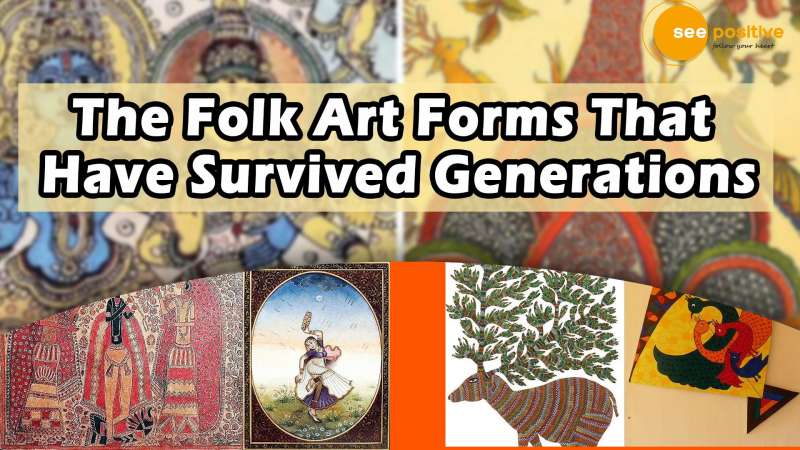

Folk painting and art techniques from ancient India have been passed down through the years and are still performed in many regions of the world today. India has long been known for its traditional arts and crafts, which showcase ethnic and cultural vibrancy.
Each of the country’s 28 states has its own particular cultural and traditional qualities, which are expressed in many types of art. Due to its traditional aesthetic sensibility and authenticity, Indian folk art has a large international commercial potential. This creativity isn’t just limited to paintings; it also extends to pottery, house decorations, ornaments, and clothing design. Madhubani, Kalamkari, Gond etc are some of the traditional paintings that have been survived till now.
MADHUBANI PAINTINGS
Mithila art (also called Madhubani painting) is a traditional Indian folk art that began in Nepal’s Janak kingdom, which is now Bihar. Madhubani is a district located near Patna, the state capital. “Forest of Honey” is the literal meaning of the name. Darbhanga, Sitamarhi, and Nepal are all close by. It was the capital of the Ancient Maithili kingdom.
Village women traditionally perform this task. The painting is used to be done on freshly plastered mud walls of huts, but now it’s done on cloth, hand-made paper, and canvas as well. Earlier the colors used in the paintings were derived from plants, but now-a-days poster and acrylic colors are used.

Nature and Hindu deities such as Krishna, Ram, Shiva, Durga, Lakshmi, and Saraswati are usually portrayed by Madhubani painters. Natural objects, as well as scenes from the Royal court and wedding ceremonies, are frequently depicted in paintings.
The picture has gained widespread acclaim in recent years. Madhubani paintings can be found at most art fairs and exhibitions. Late Mahasundari Devi is credited with removing Madhubani artwork from homes. The State Bank of India (SBI) has used the painting as the background of their debit cards.
WARLI PAINTINGS
Maharashtra’s traditional art form is Warli. The dramatic contrast expressions in these paintings make them stand out.
Basic geometric shapes such as circles, triangles, and squares dominate these paintings. These geometric forms represent natural elements in our surroundings. The sun and moon, for example, are represented by circles, while the mountains are represented by triangles, and the squares are the painting’s core elements. Two inverted triangles are connected together to represent people and animals, with the upper triangle representing the torso and the bottom triangle representing the pelvis.

Scenes depicting hunting, fishing, farming, festivals, and dances are the dominant topic of the paintings, which are surrounded by trees and animals. In times of celebration, women of the society would decorate the huts with Warli paintings. They used bamboo sticks as paintbrushes to create a painting with rice and water paste. This is also why the majority of original Warli art is painted in a red background with white paints. There are also various colors like blue, green, brown, black, and orange used in the painting .
Many artists employ the Warli art form to beautify towns and raise awareness through wall paints. It’s also used to decorate purses, bedsheets, and a variety of other objects. The Warli tribe of Maharashtra employs Warli to decorate the walls of their village dwellings as a vivid reflection of everyday and social happenings.
KALAMKARI
Kalamkari is one of the oldest and most complicated techniques for printing fabric using vegetable dyes and minerals. Kalamkari, also known as Qalamkari, is a hand-painted or block-printed cotton textile popular in India.

The name comes from the Persian words kalam (pen) and kari (craftmanship), which both mean “drawing with a pen.” The Mughals and the Golconda Sultanate patronised the craft at Pedana, near Machilipatnam in Krishna district, Andhra Pradesh.
The Srikalahasti style and the Machilipatnam style are two unique types of kalamkari art in India. The Srikalahasti form of kalamkari is fully hand crafted, with the “kalam” or pen used for free hand drawing of the subject and filling in the colours. Scrolls, temple hangings, chariot banners, and other items showed deities and scenes from Hindu mythological classics, and hence had an almost sacred identity.
Plastic buckets/drums ,Copper vessels ,Nylon brush ,Color tray ,Squeezer ,Printing table , neem or teak ,Wood etc are various equipment used in Kalamkari
GOND
As the central theme of art, Gond art includes life. It is practiced by the Central Indian “Gondi” tribe. The art form celebrates and reflects life, such as hills, streams, animals, and birds. Traditionally, the tribes painted on the mud walls of their homes.

Gond painting is a Madhya Pradesh-based traditional art form associated with the Gond people. Gond artisans create a wide range of hand-painted items, including the following: Sarees, Kurtis, Dupattas, Stoles, Trays, Boxes, and Coasters are some of the items.
Themes and Designs for Gond Painting
Gond painting takes its themes and motifs from local flora and fauna, deities, and urban culture.
The following subjects are frequently shown in Gond paintings: –
- Peacocks, birds, crabs, mythological beasts, lizards, lions, tigers, deer, snakes, wild boars, cows, monkeys, elephants, horses, fish, and other animals are among the animals shown.
- The Tree of Life – the Mahua Tree.
- Myths, folklore, and features of the Gond people’s daily lives.
- Lord Shiva, Lord Krishna, Lord Ganesha, and other Hindu gods
- Phulvari Devi (Goddess Kali), Jalharin Devi (River Goddess), Marahi Devi, and other local deities
- Folktales.


